Get Started with Object Styles
Before you get your hands on specific styles, it is nice to understand some general things all styles have in common.
There are several ways to enter the dialog. The easiest, most direct way into any style is from the Settings tab. Right-click on any style you see listed and select Edit, as shown in Figure 19-15.
Figure 19-15: Every style can be edited by right-clicking on the style name from the Settings tab of Toolspace.
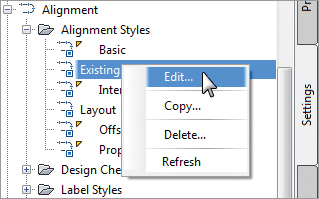
You can also enter the styles’ dialogs from the properties of any object by clicking the Edit button. Figure 19-16 shows the active styles on a point group, with the Edit buttons off to the right. Editing at this level affects all objects that use the style the same as it would if you had entered the style from the Settings tab. The downside to editing a style in this manner is that you will not immediately be able to click Apply to see your change. You’ll need to exit the style dialog and click Apply at the object level before seeing your label or object update.
Figure 19-16: An object’s properties reveal the active styles, as in this point group’s properties.
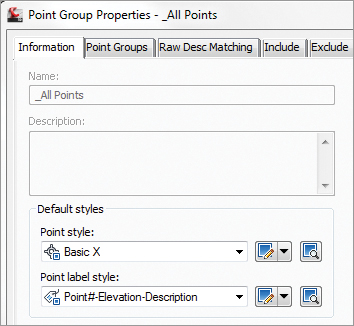
Frequently Seen Tabs
All styles, regardless of type, have a few things in common:
Information Tab The Information tab, shown in Figure 19-17, controls the name of the style.
Figure 19-17: The Information tab exists for all object and label styles, including surface styles.
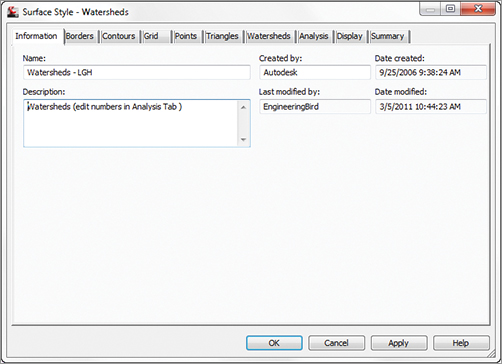
The description is always optional, but we recommend that you add some information to the style. The description can be seen in tooltip form as you search through the Settings tab.
On the right side of the dialog you will see the name of the style, the date when it was created, and the last person who modified the style. These names are initially pulled from the Windows login information and only the Created By field can be edited.
Summary Tab The Summary tab is exactly what it sounds like, that is, a summary of all other settings that exist in the style. The information from other tabs in list form as well as their override status is shown in Figure 19-18.
Figure 19-18: Summary tab of a label style

Making Sense of Child Styles and Overrides
Civil 3D styles are customizable at several levels. In the Drawing Settings area, you saw overall settings that initially affect the entire drawing. The Drawing Settings are the highest level of the settings hierarchy (the main parent settings). You will find the same settings at the object level that can diverge from the overall drawing settings. Farther down the hierarchy are the command settings. The term “child” in Civil 3D refers to any style that can also be controlled at a higher level.
For example, for most objects a precision of two decimal places (0.00) is adequate for your station work. However, for corridor creation it is advantageous to see more decimal places of precision. At the drawing level, keep the station precision to 0.00. At the Corridor level, right-click on the object to Edit Feature Settings.

Inside the Corridor Feature Settings, you will have a feeling of déjà vu from when you edited the Drawing Settings. All the same settings (and a few more object-specific ones) are here. The difference is that changing the setting here affects corridors only.

The check mark in the Override column indicates that this setting differs from settings higher up in the hierarchy of settings.
An arrow in the Child Override column indicates that further down the chain of command a style or setting differs. To force these subordinate styles to match the style of the parent, click the arrow so that a red X appears. The red X indicates that the change you make in the dialog you are looking at will get pushed to subordinate styles or settings.
Basic Object Styles
Object styles control the display of Civil 3D objects such as points, surfaces, alignments, pipes, sections, and so on.
Consider a Civil 3D surface. Sometimes you want to see the surface as contours, other times you want to see the surface as triangles, and sometimes you don’t want to see it at all. Changing what you see is not a matter of freezing and thawing layers, but it is a matter of changing the active style. Think of the active style on an object as a wrapper. A surface model will have many potential wrappers depending on what you want to see. The underlying data does not change, but the representation of the data will change.
Object styles have quite a few things in common with each other. Almost every object style has a Display tab.
Display Tab
Inside the Display tab, you will see a list of the various components that can be displayed for the object you are working with. In Figure 19-19 you can see that a general-purpose marker contains only one component (the marker itself) and a surface model has components for contours, triangles, points, and more (as seen toward the bottom of Figure 19-19).
Figure 19-19: A simple marker style (top) and a more complex surface style (bottom)

While other tabs in an object style control the specifics of how certain components look, the Display tab controls if the component displays at all. The visibility lightbulb indicates whether the component will be displayed when the style is applied to the object. In the bottom of Figure 19-19, you can see that triangles, border, major contours, and minor contours will all display for the Surface object style.
Each component will have a layer designation. You may be wondering, “Didn’t we set a surface layer back in the object settings?” Yes, you did. Those were overall object layers. The layers we see here are component layers. Using the analogy of a base AutoCAD block, the Object layer can be thought of in the same way as a block insertion layer. The object component layers can be thought of in the same way as layers inside the block definition.
This is Civil 3D, of course, so the objects exist in three dimensions. View Direction controls the display of an object depending on how you are looking at it. Certain items, such as a profile view, are intended to only be seen in plan, so they do not have multiple view directions listed. A marker, on the other hand, can be shown in plan, model, profile, or section, as seen in Figure 19-20. Surface models make an appearance in plan, model, and section, as shown in Figure 19-20.
Figure 19-20: View Directions for the marker style

Marker Tab
Marker styles and point styles both contain a Marker tab (Figure 19-21). The Marker tab controls what symbol or block is used, its rotation, and how it should be sized when it is placed in the drawing.
Figure 19-21: Marker tab for the Benchmark point style
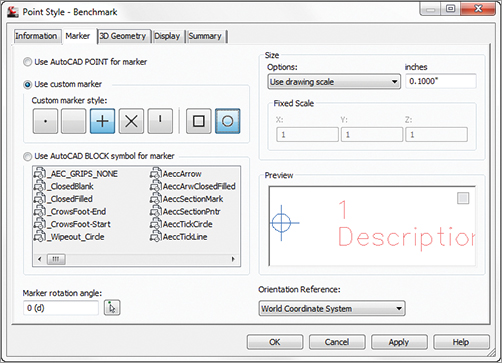
There are three symbol types that can be used. Use Custom Marker and Use AutoCAD BLOCK Symbol For Marker are the best options. Use AutoCAD POINT For Marker is a poor choice because it uses the symbol specified by the DDPTYPE setting and is difficult to control. When you choose the Use Custom Marker option, you can select a combination of symbols to mix and match.
When you choose the Use AutoCAD BLOCK Symbol For Marker option, you will be able to access a listing of blocks in your drawing. If the block you are after does not yet exist in the drawing, you can right-click in the block listing and choose Browse, as shown in Figure 19-22.
Figure 19-22: Right-click to browse for a block if it is not already defined in your drawing.

The Size options control how the symbol is scaled when inserted in the drawing (Figure 19-23). The most common options used for this are the Use Drawing Scale and Use Size In Absolute Units.
Figure 19-23: Size Options for marker display
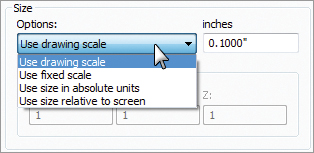
- Use Drawing Scale allows you to specify the plotted size of the symbol. The model space size of the symbol will be the size specified in the style multiplied by your annotation scale.
- Use Fixed Scale will scale the symbol based on the X, Y, and Z scale set in the style. This option will also use the Fixed scale factor in the description key set when used with a survey point.
- Use Size In Absolute Units is the option you will use in point styles that vary in size based on a survey description. For example, if this is a TREE symbol and you want the size of the symbol to reflect the trunk diameter in feet, set this to 1.
- Use Size Relative To Screen allows you to specify the size of the symbol as a percentage of your screen. This setting is annoying, because the marker will constantly change size as you zoom in or out. We do not recommend that you enable it.
Orientation Reference (as seen in the bottom right corner of Figure 19-21) controls whether the symbol stays rotated with the view, world coordinate system, or, in the case of survey points, the object. In most cases, the Orientation Reference setting should be set to World Coordinate system.
Create a Marker Style
Now get your hands on some object styles. You will start with simple styles and work your way up in complexity as this chapter progresses.
Markers are used in many places throughout Civil 3D. They are called from other styles to show vertices on civil objects, as label location marks, or as a marker to indicate the start of a flow line.
1. Open the Civil 3D Template-in-progress.dwg drawing file, which you can download from this book’s web page.
2. From the Settings tab of Toolspace, choose General Multipurpose Styles Marker Styles. Right-click on Marker Styles and select New.
3. On the Information tab, name the style VPI Marker. Give the marker the description Use to indicate vertical PI in profiles. Click Apply. Your login name is listed in the Created By and Last Modified By fields.
4. Switch to the Marker tab. Set the marker type to Use AutoCAD BLOCK Symbol For Marker. In the block listing, highlight STA by clicking on it. Set the size to 0.2″. Leave all other Marker settings at their defaults.
5. Switch to the Display tab. For Plan, Model, Profile, and Section view directions, set the layer to C-ROAD-PROF-STAN-GEOM and set the color to BYLAYER.
6. Click OK to complete the marker style.
7. Save the drawing for the next exercise.
Create a Survey Point Style
Survey Point styles contain many of the same options as Marker styles. As you work through the following example, you will perform many of the same steps as the previous exercise.
1. Continue working in the drawing Civil 3D Template-in-progress.dwg file, which you can download from this book’s web page.
2. From the Settings tab of Toolspace, choose Point Point Styles. Right-click on Point Styles and select New.
3. On the Information tab, name the style TRUNK. Add a description of Simple circle representing trunk diameter in inches.
4. On the Marker tab, click the radio button Use Custom Marker. Click the blank marker option from the group of symbols on the left. Click to add the circle option on the right. Set the Size option to Use Size In Absolute Units. Set the size to 0.0833. This value will scale down the symbol so the trunk diameter represents inches.
5. Switch to the Display tab. For Plan, Model, Profile, and Section view directions, set both the Marker and Label layers to V-NODE-TREE. Leave the other settings at their defaults.
Hint! To save time in this step use the Shift key to multiselect the Marker and Label components, as shown in Figure 19-24. When you select the layer, it will apply to both components.
Figure 19-24: Use the Shift key on your keyboard as you click the components to multiselect.
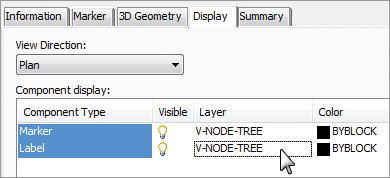
6. Click OK to complete the point style.
7. Save the drawing for the next exercise.
Linear Object Styles
In this section, you will see some linear styles such as alignments, profiles, and parcels. Hopefully, you are already seeing that concepts from one type of style often apply to other types of object styles. For alignment and profile styles, this is especially true.
Both alignment and profiles styles have a Design tab, as shown in Figure 19-25. In the case of the alignment styles, the Enable Radius Snap option restricts the grip-edit behavior of alignment curves. If you enable this option and set a value of 0.5′, the resulting radius value of curves will be rounded to the nearest 0.5′. In the case of profiles, the curve tessellation distance is a little more abstract. Curve tessellation refers to the smoothing factor applied to the profile when viewing it in 3D. Most users leave these settings at their default values.
Figure 19-25: Design tabs exist in both alignment and profile object styles.
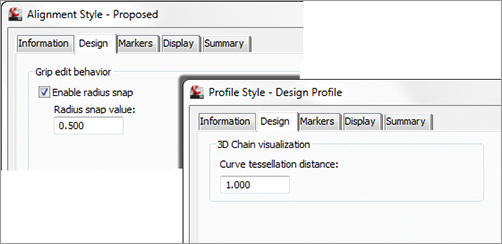
Alignment and profile have very similar Markers tabs. This tab is where you can place markers (like the one you created in the first exercise of the chapter) at specific geometry points. Figure 19-26 shows the markers assigned to various locations along an alignment.
Figure 19-26: Markers for an alignment style
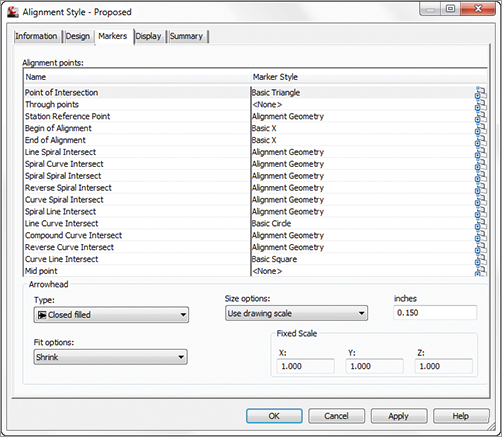
At the bottom of Figure 19-26 you see arrowhead information. Both alignments and profiles have the option of showing a direction arrow on each segment. Most people choose to omit this by turning the Arrow component off in the Display tab or setting the component to a layer that is set to No Plot. You should consider the latter, as knowing the direction of an alignment comes in handy when designing roundabouts, as you saw in Chapter 10, “Advanced Corridors, Intersections, and Roundabouts.”
Figure 19-27 shows some commonly highlighted geometry points and components in an alignment. The markers in Figure 19-27 correspond to the markers displayed in Figure 19-26.
Figure 19-27: Example alignment with geometry highlighted by style

Figure 19-28 shows the Markers tab for the profile style. It looks pretty similar to the alignment Markers tab, don’t you think?
Figure 19-28: Profile Markers tab
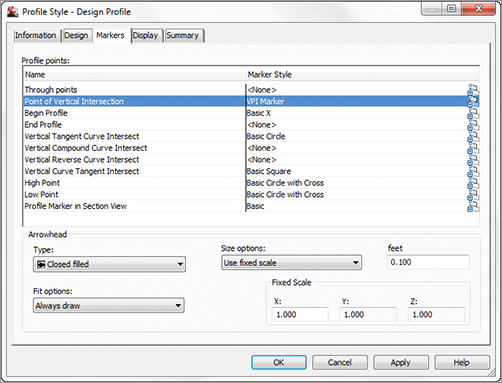
Figure 19-29 shows the corresponding graphic for the markers used in Figure 19-28.
Figure 19-29: Profile geometry highlighted by style
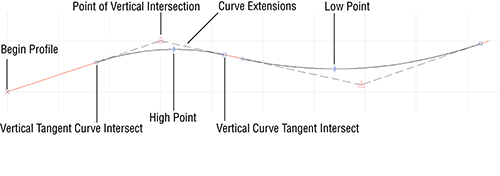
Create an Alignment Style
Alignment styles can be helpful in identifying key design components, as well as showing the stationing direction. Use multiple alignment styles to visually differentiate centerline alignments from supplemental alignments such as offset alignments and curb return alignments.
In the following exercise, you will create a style that restricts radius grip edits to five-foot increments and displays basic alignment components.
1. Continue working in the Civil 3D Template-in-progress.dwg drawing file; if you have not completed the previous section exercises, open Civil 3D template-in-progress2.dwg. You can download either file from this book’s web page.
2. From the Settings tab of Toolspace, choose Alignment Alignment Styles. Right-click on Alignment Styles and select New.
3. On the Information tab, name the style Centerline.
4. Switch to the Design tab and place a check mark next to Enable Radius Snap. Set the Radius Snap value to 5. Remember: To see the Help document about any dialog, press F1 on your keyboard to be taken directly to the help section for that topic.
5. Switch to the Markers tab. Set the Point Of Intersection marker by double-clicking the current value of <none>. Select PI Point from the marker listing and click OK. Set the Through Points marker to <None>. Set the Station Reference Point marker to <None>.
6. Switch to the Display tab. For the Plan View Direction, turn off the display components for Arrow, Line Extensions, and Curve Extensions. Use the Shift key to select Line, Curve, and Spiral together. Click the layer to set all three items to the layer C-ROAD-CNTR. Leave the Model and Section view directions at their defaults.
7. Click OK to complete the style. Save the drawing.
Parcel Styles
The parcel styles have several unique features that make them different from other styles.
In the Design tab of a parcel (shown in Figure 19-30a), you see parcel-specific options. A fill distance can be specified to place a hatch pattern along the perimeter of the parcel. This setting is useful to differentiate “special” parcels such as parks, limits of disturbance, or environmentally sensitive areas.
The fill distance indicates the width of the hatch pattern. On the Display tab, be sure to put the hatch component on its own layer so that it can be turned off independently from the parcel itself, as hatches tend to slow down the graphic. Figure 19-30b shows the parcel graphic resulting from the design settings shown.
Feature Line Styles
Feature lines are found in quite a few different places. They are created automatically as part of corridors, created as a result of grading, or can be created independently by the user. Because their scope crosses functionality, you will find feature line styles in the General Multipurpose Styles collection in Settings.
By definition, a feature line is a 3D object; therefore, its style can be controlled in plan, profile, and section. As shown in Figure 19-31, a feature line can use markers at geometry points.
Figure 19-30: Parcel style options and the resulting parcel graphic
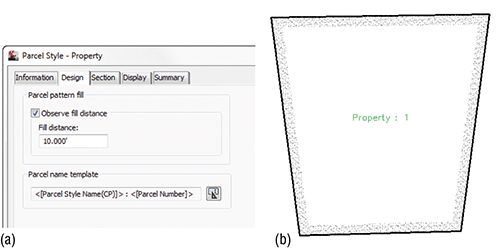
Figure 19-31: Feature line profile marker options (left) and section option (right)

Surface Styles
Surface styles are the most widely used styles in any Civil 3D project. Depending on which style is active, certain editing options may be restricted. For example, you need to see triangle vertices before Civil 3D will let you use the Delete Point command.
Each tab in the Surface Style dialog corresponds to components listed in the Display tab. Remember, the Display tab only determines whether or not the component shows at all, but it does not control the specifics of how the component should be shown.
Once a surface is created, you can display information in a large number of ways. The most common so far has been contours and triangles, but these are the basics. By using varying styles, you can show a large amount of data with one single surface. Not only can you do simple things such as adjust the contour interval, but Civil 3D can apply a number of analysis tools to any surface:
Contours Allows the user to specify a more specific color scheme or linetype as opposed to the typical minor-major scheme. Commonly used in cut-fill maps to color negative colors one way, positive contours another, and the balance or zero contours yet another color.
Elevations Creates bands of color to differentiate various elevations. This can be a simple weighted distribution to help in creation of marketing materials, hard-coded elevations to differentiate floodplain and other elevation-driven site concerns, or ranges to help a designer understand the earthwork involved in creating a finished surface.
Direction Analysis Draws arrows showing the normal direction of the surface face. This is typically used for aspect analysis, helping site planners review the way a site slopes with regard to cardinal directions and the sun.
Slopes Analysis Colors the face of each triangle on the basis of the assigned slope values. While a distributed method is the normal setup, a common use is to check site slopes for compliance with Americans with Disabilities Act (ADA) requirements or other site slope limitations, including vertical faces (where slopes are abnormally high).
Slope Arrows Displays the same information as a slope analysis, but instead of coloring the entire face of the TIN, this option places an arrow pointing in the downhill direction and colors that arrow on the basis of the specified slope ranges.
User-Defined Contours Refers to contours that typically fall outside the normal intervals. These user-defined contours are useful to draw lines on a surface that are especially relevant but don’t fall on one of the standard levels. A typical use is to show the normal pool elevation on a site containing a pond or lake.
In the following exercises, you will walk through the steps of creating or modifying surface styles.
Contour Style
The first style you create will be a contour display style. You will also manipulate the triangle display so that the elevations are more obvious when viewed in 3D.
1. Open the Surface Styles.dwg drawing file, which you can download from this book’s web page.
2. From the Settings tab of Toolspace, choose Surface Surface Styles. Right-click Surface Styles and select New.
3. On the Information tab, name the style Existing Contours. Add a description indicating that this style will show 2′ minor contours and have a 5× exaggeration when viewed in 3D.
4. On the Contours tab, expand the Contour Intervals category. Set the Minor Interval to 2′. Set the Major Interval to 4′. The Contours tab will now look like Figure 19-32.
Figure 19-32: The Contours tab in the Surface Style dialog
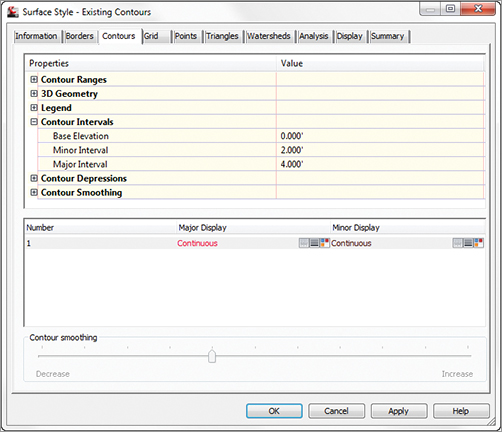
5. Switch to the Triangles tab. Change Triangle Display Mode to Exaggerate Elevation. Set Exaggerate Triangles By Scale Factor to 5.00 (see Figure 19-33).
Figure 19-33: Exaggerate the elevations seen in the Object Viewer.

6. On the Display tab, Shift+click to highlight all the components. Set all the component colors to BYLAYER. While all the components are still highlighted, set Linetype to ByLayer as well.
Step 5 rectifies a quirk with new surface styles. If you are a true CAD stickler, you will try to make as many items as possible set to BYLAYER. This approach greatly simplifies things if you need to change color or linetype. In some cases, setting a style component may not be practical. For surfaces, however, you can stick to your BYLAYER guns.
You will only be using the Minor Contour in this style, but later on you will copy this style and your efforts will be carried forward.
7. Click on the Minor Contour component so it is the only component highlighted. Turn this component’s visibility on by clicking the lightbulb icon. Set the layer to C-TOPO-MINR. Turn off all other components for the Plan View Direction. Your Display tab should now resemble Figure 19-34.
Figure 19-34: Minor Contour flying solo in plan

8. Change your View Direction to Model. Verify that Triangles are the only component turned on. Set the Triangles layer to C-TINN. Set Color and Linetype both to BYLAYER.
To see the surface in the Object Viewer or in any other 3D view, you must have triangles set to display in Model, as shown in Figure 19-35.
Figure 19-35: Triangle component set to display in Model
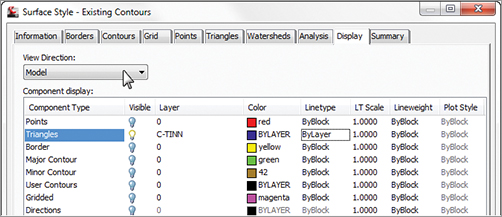
9. Click OK to complete the style. Save the drawing.
10. Select the surface (shown as Border Only) and click Surface Properties from the context tab. Set Surface Style to Existing Contours. Click OK.
After the style is applied to the surface model, you should see simple contours in plan view (Figure 19-36a) and an exaggerated surface model in the Object Viewer (Figure 19-36b).
Figure 19-36: Your new style shown in plan and in Object Viewer
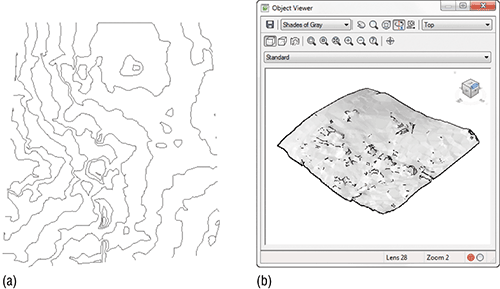
Triangle and Points Surface Style
The next style you create will help facilitate surface editing. To work with the Swap Edge or Delete Line Surface edits, you must be able to see triangles. To work with the Delete Point, Modify Point, and Move Point commands, you must be able to see triangle vertices.
It is important to note that the points you see in the surface style do not refer to survey points. The points you are working with in this exercise are triangle vertices. The triangle vertices and survey points will initially be in the same locations for a surface built from points. However, as breaklines are added or edits are made to the triangle vertices, the surface model will differ from the original survey.
1. Continue working in the drawing file Surface Styles.dwg, which you can download from this book’s web page.
2. From the Settings tab of Toolspace, choose Surface Surface Styles. Right-click the Existing Contours style you created in the previous exercise and select Copy, as shown in Figure 19-37.
Figure 19-37: Copy is one of the options you will find when right-clicking directly on the style name.
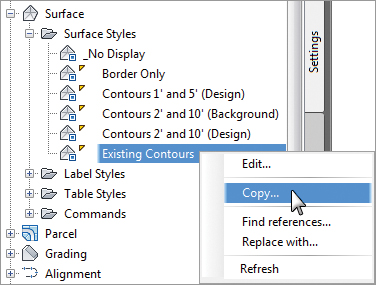
3. On the Information tab, rename the surface style to Surface Editing. Add a description to reflect that this style will show points and triangles and will be used for editing purposes.
4. Switch to the Points tab. Expand Point Display and click the ellipsis for Data Point Symbol. Set the point type to the circle with a plus sign, as shown in Figure 19-38.
Figure 19-38: Change the point display so triangle vertices stand out.
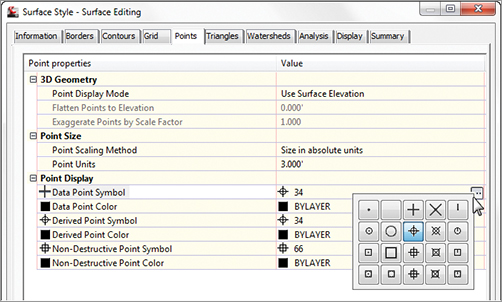
5. Switch to the Triangles tab. Remove the exaggeration by setting the Triangle display mode back to Use Surface Elevation.
6. Switch to the Display tab. Use the light bulb icon to turn off visibility for Minor Contour, and turn it on for Points and Triangles. Create a new layer for the point display called C-TINN-PNTS. Make the new layer Red. Set the Points component layer to the new layer. Set the Triangles component to the C-TINN layer. Your Display tab will resemble Figure 19-39.
Figure 19-39: Change the Points and Triangles layers in the Display tab.
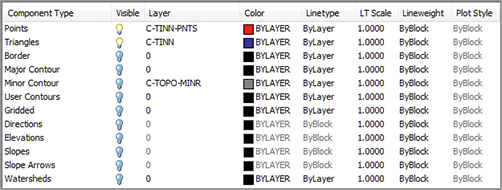
7. Click OK to complete the style. Use the same procedure from the previous exercise to apply the Surface Editing style to the surface. Your surface will now resemble Figure 19-40.
Figure 19-40: Triangles and points shown using the new surface style

Watershed Analysis Style
The next style you will create in this chapter will be a watershed analysis style. Analysis styles are unique in several ways. To see the style applied to your design, you must run the analysis in the surface properties in addition to applying the style to the surface. The elevation and slope analysis styles do not let you set a layer for the components because the colors and behavior are set on the Analysis tab.
These distribution methods show up in nearly all the surface analysis methods. Here’s what they mean:
Quantile This method is often referred to as an equal count distribution and will create ranges that are equal in sample size. These ranges will not be equal in linear size but in distribution across a surface. This method is best used when the values are relatively equally spaced throughout the total range, with no extremes to throw off the group sizing.
Equal Interval This method uses a stepped scale, created by taking the minimum and maximum values and then dividing the delta into the number of selected ranges. This method can create real anomalies when extremely large or small values skew the total range so that much of the data falls into one or two intervals, with almost no sampled data in the other ranges.
Standard Deviation Standard Deviation is the bell curve that most engineers are familiar with, suited for when the data follows the bell distribution pattern. It generally works well for slope analysis, where very flat and very steep slopes are common and would make another distribution setting unwieldy.
In the following exercise, you will create a surface style for watershed analysis. To apply the new style to the surface, you must also run the analysis.
1. Continue working in the drawing file Surface Styles.dwg, which you can download from this book’s web page.
2. From the Settings tab of Toolspace, choose Surface Surface Styles. Right-click the Existing Contours style you created in the first exercise and select Copy.
3. On the Information tab, rename the surface style to Watershed Analysis. Add a description to reflect that this style will show watersheds and slope arrows.
4. Switch to the Watersheds tab. Expand the Boundary Segment Watershed area. Set the Use Hatching option to False. Expand the Multi-drain Watershed area. Set the Use Hatching option to False. Your Watersheds tab will now look like Figure 19-41.
Figure 19-41: Changing the hatch options for watershed areas
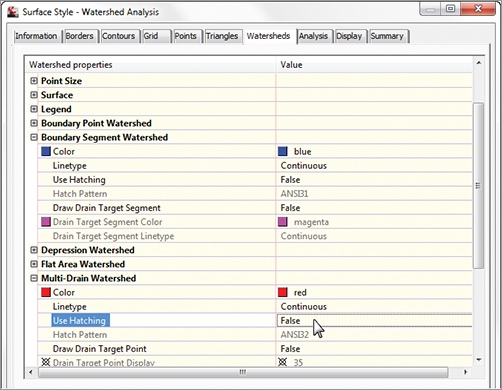
5. Switch to the Analysis tab. Expand the Slope Arrows area. Change Scheme to Hydro. Change Arrow Length to 2′. The Analysis tab will now resemble Figure 19-42.
Figure 19-42: Set the color scheme and arrow length in the Analysis tab.

6. Switch to the Display tab. Turn off visibility for the Minor Contour component, and turn it on for Slope Arrows and Watersheds. Set the Watershed layer to C-TINN-VIEW. Click OK to complete the style.
7. Select the surface and open Surface Properties. Set Watershed Analysis as the surface style.
8. Switch to the Analysis tab. Set the Analysis type to Watersheds. Set the Merge Depressions value to 0.4. Place a check mark next to Merge Adjacent Boundary Watersheds. Click the down arrow to run the analysis. Your Surface Properties Analysis tab should now resemble Figure 19-43.
Figure 19-43: You must run the analysis in surface properties before the watershed style kicks in.

9. Click OK to close the surface properties. Your surface model should now resemble Figure 19-44.
Figure 19-44: The completed analysis style applied to the surface
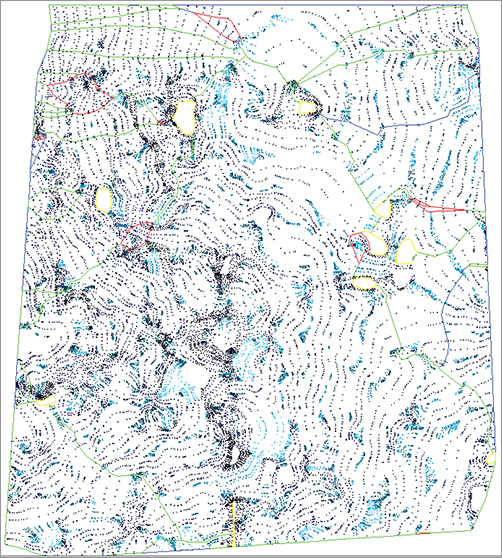
Elevation Banding
The last surface style you will create in this chapter is an elevation banding style:
1. Continue working in the drawing file Surface Styles.dwg, which you can download from this book’s web page.
2. From the Settings tab of Toolspace, choose Surface Surface Styles. Right-click the Existing Contours style you created in the first exercise and select Copy.
3. On the Information tab, rename the surface style to Elevations. Add a description to reflect that this style will show elevation banding.
4. Switch to the Analysis tab, and expand the Elevations listing. Change Range Color Scheme to Rainbow, as shown in Figure 19-45.
Figure 19-45: Elevation analysis options
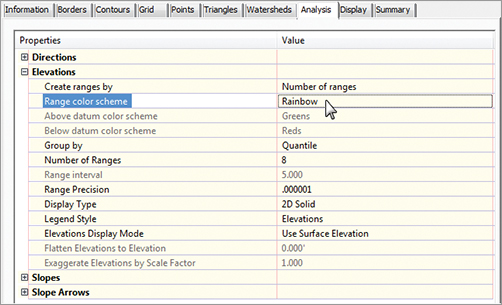
5. On the Display tab, turn off the display for all components except Elevations. Notice that you do not have a layer option for this item because the color and behavior is controlled by the analysis. Click OK to complete the style.
6. Use the same procedure from the previous exercises to apply the Elevations style to the surface. Your surface will now resemble Figure 19-46.
Figure 19-46: Pretty rainbow! The elevation style applied to the surface

Pipe and Structure Styles
In Chapter 13, you learned that the best way to manage pipes and structures was in a parts list. One of the functions of a parts list is to associate styles to pipes and structures. In this section, you will learn how to create the pipe and structure styles that are used by a parts list.
In your template, you will have multiple styles for the various parts lists. You will want to have separate styles for water systems, storm sewers, and sanitary sewers. Additionally, you may want to have separate styles for existing and proposed systems. The main difference between the styles for the different systems will be the layers you set in the Display tab.
Pipe Styles
It seems like no two municipalities want pipes displayed the same way on construction documents. Luckily, Civil 3D is very flexible in how pipes are shown. With a single pipe style, you can control how a pipe is displayed in Plan, Profile, and Section views. You can use multiple pipe styles to graphically differentiate larger pipes from smaller ones. This section explores all of the options.
The Plan Tab The tab you see in Figure 19-47 controls what represents your pipe when you’re working in plan view.
Figure 19-47: The Plan tab in the Pipe Style dialog

Options on the Plan tab include the following:
Pipe Wall Sizes You have a choice of having the program apply the part size directly from the catalog part (that is, the literal pipe dimensions as defined in the catalog) or specifying your own constant or scaled dimensions.
Pipe Hatch Options If you choose to show pipe hatching, this part of the tab gives you options to control that hatch. You can hatch the entire pipe to the inner or outer walls, or you can hatch the space between the inner and outer walls only, as shown in Figure 19-48.
Figure 19-48: Pipe hatch to inner walls (a), outer walls (b), and hatch walls only (c)
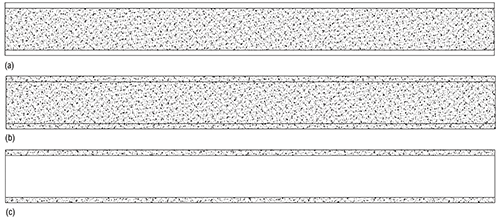
Pipe End Line Size If you choose to show an end line, you can control its length with these options. An end line can be drawn connecting the outer walls or the inner walls, or you can specify your own constant or scaled dimensions. The pipes from Figure 19-48 are all shown with pipe end lines drawn to outer walls.
Pipe Centerline Options If you choose to show a centerline, you can display it by the lineweight established in the Display tab, or you can specify your own part-driven, constant, or scaled dimensions. Use this option for your sanitary pipes in places where the width of the centerline widens or narrows on the basis of the pipe diameter.
The Profile Tab The Profile tab (see Figure 19-49) is almost identical to the Plan tab, except the controls here determine what your pipe looks like in profile view. The only additional settings on this tab are the crossing-pipe hatch options. If you choose to display crossing pipe with a hatch, these settings control the location of that hatch.
Figure 19-49: The Profile tab in the Pipe Style dialog

The Section Tab If you choose to show a hatch on your pipes in section, you control the hatch location on this tab (see Figure 19-50).
Figure 19-50: The Section tab in the Pipe Style dialog

In the examples that follow, you will create various types of pipe styles.
The first style is for a situation where the pipe must be shown in plan view with a single line, the thickness of which matches the pipe inner diameter. In profile, the pipe will show the inner diameter lines and in section, it will show as a hatch-filled ellipse.
1. Open the drawing Pipe and Structure Styles.dwg, which you can download from this book’s web page.
2. From the Settings tab of Toolspace, choose Pipe Pipe Styles. Right-click Pipe Styles and select New.
3. On the Information tab, rename the style to Proposed Storm CL.
4. On the Plan tab, set the Pipe Centerline options to Specify Width. Set Specify Width to Draw To Inner Walls.
5. On the Profile tab, no changes are needed. On the Section tab, change the radio button to Hatch To Inner Walls.
6. On the Display tab, make these changes:
- In Plan View Direction, turn off all components except Pipe Centerline. Set the Pipe Centerline layer to C-STRM-PIPE.
- Change View Direction to Profile. Make Inside Pipe Walls the only visible component. Set the layer to C-STRM-PIPE.
- Change View Direction to Section. Set Crossing Pipe Inside Wall to the C-STRM-PIPE layer and make it visible. Set Crossing Pipe Hatch to the C-STRM-PIPE-PATT layer and make it visible. Turn off Crossing Pipe Outside Wall. At the bottom of the dialog, set Crossing Pipe Hatch to SOLID, as shown in Figure 19-51.
Figure 19-51: Hatch pattern display for the Section view direction

7. Click OK. The style is complete.
8. Select the rightmost pipe and open the Pipe Properties dialog. Change the style of the pipe to Proposed Storm CL. Click OK. Save the drawing to use in the next exercise.
Examine the pipe in plan, profile, and cross section. In plan, it should be a solid line. In section, it should be a filled pipe.
Hey! Why Does My Pipe Look like an Octagon?
Civil 3D helps itself perform better on large drawings by knocking down the resolution of 3D curved objects, such as the pipe in the cross section view in the previous steps.
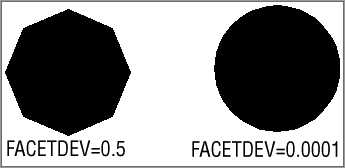
The system variable you can use to make these pipes look nicer is Facet Deviation, or FACETDEV. The default FACETDEV value for any English unit drawing is 0.5 inches. In metric drawings, the default is 10 millimeters. The lower the FACETDEV value, the smoother the 3D curve.
Note that another variable, FACETMAX, controls the maximum number of facets on any curved object. The Civil 3D default of 500 facets is usually more than enough to display a Civil 3D pipe smoothly.
In the next pipe style example, you will create a style that uses several options for hatching pipe walls:
1. Continue working in the drawing Pipe and Structure Styles.dwg.
2. From the Settings tab of Toolspace, select Pipe Pipe Styles. Right-click Pipe Styles and select New.
3. On the Information tab, rename the style to Proposed Double-Wall Storm.
4. On the Plan tab, verify that the Pipe Hatch options are set to Hatch Walls Only.
5. On the Profile tab, verify that the Pipe Hatch options are set to Hatch Walls Only.
6. On the Display tab, do the following:
- In Plan View Direction, the components that should be visible are Inside Pipe Walls, Outside Pipe Walls, Pipe End Line, and Pipe Hatch. Set all four layers to C-STRM-PIPE.
- In Profile View Direction, the components that should be visible are Inside Pipe Walls, Outside Pipe Walls, Pipe End Line, and Pipe Hatch. Set all four layers to C-STRM-PIPE.
- In Section View Direction, turn off Crossing Pipe Outside Wall. Set the layer for Crossing Pipe Inside Wall to C-STRM-PIPE.
7. Click OK to complete the style. Use the Pipe Properties dialog to apply the new style to the leftmost pipe.
8. Save the drawing to use in the next exercise.
The last pipe style example demonstrates how to create a crossing pipe override style:
1. Continue working in the drawing Pipe and Structure Styles.dwg.
2. From the Settings tab of Toolspace, select Pipe Pipe Styles. Right-click Pipe Styles and select New.
3. On the Information tab, rename the style to Proposed Profile Crossing.
4. Switch to the Display tab.
5. For Plan View Direction, turn off visibility for all components.
6. For Profile View Direction, turn off visibility for all components except Crossing Pipe Inside Wall. Set Crossing Pipe Inside Wall to the C-STRM-PROF layer.
7. Click OK. The style is complete.
8. Pan over to the profile view in the drawing. Click the profile view and select Profile View Properties from the context tab.
9. In the Profile View Pipe Networks tab, place a check mark in the Style Override column for Pipe - (15). Set the style for the style override to Proposed Profile Crossing, as shown in Figure 19-52.
Figure 19-52: Override the pipe style in Profile View Properties
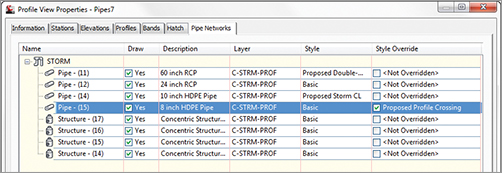
10. Click OK.
After all three pipe style exercises are complete, your profile view will resemble Figure 19-53.
Figure 19-53: The completed exercise in profile
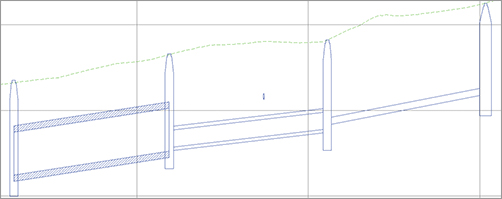
Structure Styles
The following tour through the structure-style interface can be used for reference as you create company standard styles:
The Model Tab This tab (Figure 19-54) controls what represents your structure when you’re working in 3D. Typically, you want to leave the Use Catalog Defined 3D Part radio button selected so that when you look at your structure, it looks like your concentric manhole or whatever you’ve chosen in the parts list.
Figure 19-54: The Model tab in the Structure Style dialog
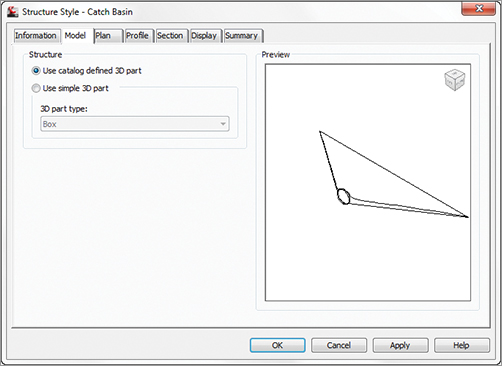
The Plan Tab The Plan tab (Figure 19-55) enables you to compose your object style to match that specification.
Figure 19-55: The Plan tab in the Structure Style dialog
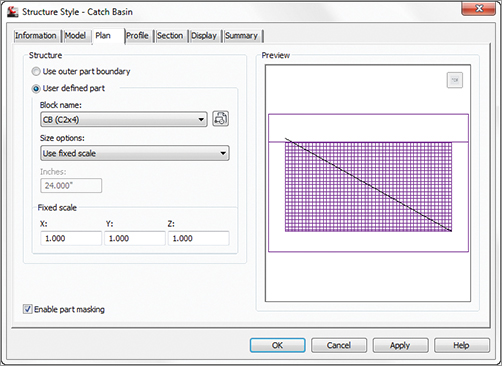
Options on the Plan tab include the following:
Use Outer Part Boundary This option uses the limits of your structure from the parts list and shows you an outline of the structure as it would appear in the plan.
User Defined Part This option uses any block you specify. In the case of your sanitary manhole, you chose a symbol to match the CAD standard.
Size Options The options in this drop-down are similar to what you see in other places in Civil 3D. Use Size In Absolute Units is a common way to represent a manhole at actual size. Use Drawing Scale will treat the object like an annotative block.
Enable Part Masking This option creates a wipeout or mask inside the limits of the structure. Any pipes that connect to the center of the pipe appear trimmed at the limits of the structure.
The Profile Tab Once you know what your structure must look like in the profile, you use the Profile tab (Figure 19-56) to create the style.
Figure 19-56: The Profile tab in the Structure Style dialog

Options on the Profile tab include the following:
Display As Solid This option uses the limits of your structure from the parts list and shows you the mesh of the structure as it would appear in profile view.
Display As Boundary This option uses the limits of your structure from the parts list and shows you an outline of the structure as it would appear in profile view. You’ll use this option for the sanitary manhole.
Display As Block This option uses any block you specify.
Size Options The options in this drop-down apply to most blocks placed by Civil 3D.
Enable Part Masking This option creates a wipeout or mask inside the limits of the structure. Any pipes that connect to the center of the pipe appear trimmed at the limits of the structure.
In the following exercise, you’ll create a new structure style that uses a block in plan view to represent a catch basin. Because the block is drawn at actual size, you will use the size option Use Fixed Scale.
1. Continue working in the drawing Pipe and Structure Styles.dwg, which you can download from this book’s web page. If you have not completed the pipe styles exercises, that’s okay—completing the previous section is not required to continue.
2. From the Settings tab of Toolspace, select Structure Structure Styles. Right-click Structure Styles and select New.
3. On the Information tab, rename the style to Catch Basin.
4. On the Plan tab, in the Structure panel choose the User Defined Part radio button. Select the Block name CB(C2x4) from the list box. Set Size to Use Fixed Scale and leave the X, Y, and Z scale factors set to 1.
5. On the Display tab, set View Direction to Plan. Set the Structure layer to C-STRM-STRC.
6. Repeat step 5 for all remaining view directions (Model, Profile, and Section).
7. Click OK to complete the style.
8. Select the rightmost structure in the drawing. On the context tab, click Structure Properties. On the Information tab of the Structure Properties dialog, set the style to Catch Basin.
Blocks can be used anywhere a structure is shown. You have the option of inserting the blocks at Rim or Sump. In the case of a flared end section, there need to be blocks for both a left-facing view and right-facing view. In the next exercise you will edit an existing style to fix some “quirks.”
1. Continue working in the drawing Pipe and Structure Styles.dwg. Completing the previous section is not required to continue.
2. Select the leftmost structure in plan view. Open the structure’s properties and change the active style to Flared End Section. Click OK to close the Structure Properties dialog.
3. Select the structure and rotate it so the flared end opens to the left. (The structure will be smaller than the pipe.)
4. Zoom out and take a look at what is going on in profile view.
The style is set incorrectly, causing the flared end section symbol to dive down to zero. A block is being used for the flared end section and looks pretty horrible. The block is even facing the wrong direction!
5. From the Settings tab of Toolspace, choose Structure Structure Styles. Right-click Flared End Section and select Edit.
6. On the Information tab, rename the style to Flared End Section - L.
7. Switch to the Profile tab. Choose Sump from the Block Insertion Location drop-down.
Click the Browse button next to the Block Name option. Select the block from the Mastering dataset called FES-L.dwg. Set Size Options to Use Fixed Scale. Set the X and Y values to 4. Your flared end section Profile tab should now resemble Figure 19-57.
Figure 19-57: Flared end section done properly
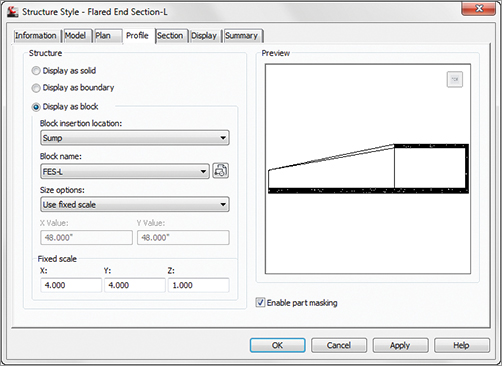
8. Click OK to complete the style.
